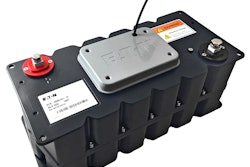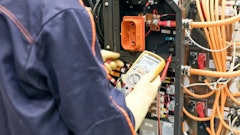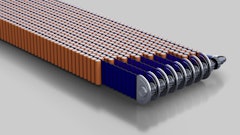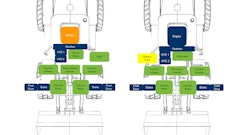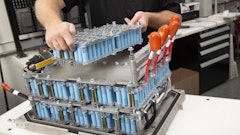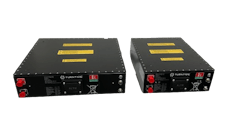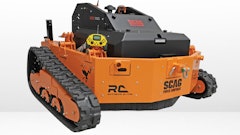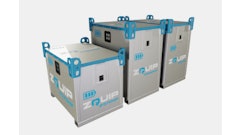![Computational Fluid Dynamics analysis of a pouch-style battery with liquid cooling at two different power levels. [Source: Wu Z., Haugg A., Kemper H., Pischinger S. “Optimal Cooling Solution for High-Power Automotive Battery Module” EVS 31 & EVTeC 2018 Japan on October 2, 2018]](https://img.oemoffhighway.com/files/base/acbm/ooh/image/2018/11/AKG_Battery_Cooling_photo_3.5bdaf0cbcc7d0.png?auto=format%2Ccompress&q=70&w=400)
With the charging speed and power density of the latest lithium-ion batteries, active and passive cooling is becoming a key factor in electric vehicle battery life. AKG collaborated with FH Aachen and RWTH Aachen University to find the best combination of cooling technology for a 48V high-power battery module. For an ideal temperature gradient across the battery, use a combination of side-cooling, inter-cell cooling, and thermally conductive fill material.
The research used computational fluid dynamics (CFD) and finite element analysis (FEA) to test various configurations. The goal was to find a solution to keep the average temperatures of individual cells – not just the average temperature of the battery module – between 15 and 40 C. Analyses included 280 W, 560 W, and 840 W heat generation rates. Along with maintaining an ideal temperature range, maintaining a small temperature gradient across each cell would further improve the outcome. ![Example of one type of cooling system designed for pouch-style batteries. [Source: AKG]](https://img.oemoffhighway.com/files/base/acbm/ooh/image/2018/11/Kobe_Prototyp_Pouch_cell__Entwurf.5bdaf0cbb2fc7.png?auto=format%2Ccompress&fit=max&q=70&w=400) Example of one type of cooling system designed for pouch-style batteries. [Source: AKG]
Example of one type of cooling system designed for pouch-style batteries. [Source: AKG]
Using active cooling with water-glycol on the sides of the cells, and passive internal cooling plates, both temperature maximum and temperature gradient are managed cost-effectively.
The addition of a suitable fill material for high-power battery applications significantly improves the heat transfer to the cooling system, allowing the design to exceed its goal.
The successful design optimization project was presented at the EVS 31 & EVTeC 2018 joint event in Japan on October 2. A full copy of the paper “Optimal Cooling Solution for High-Power Automotive Battery Module” is available through the Society of Automotive Engineers of Japan, Inc.





